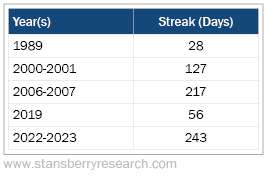Editor’s note: A few weeks ago, I (Vic Lederman) wrote about something that keeps me up at night…
I was talking about what some folks in the industry call the “Fed spread.” More specifically, when this indicator inverts, it’s also known as the “inverted yield curve.”
Brett Eversole, my friend and an editor at our corporate affiliate Stansberry Research, also talked about this idea in his free DailyWealth e-letter earlier this month. He took a deep dive into the inverted yield curve over the past 40 years.
Today, I want to share Brett’s findings with you. As you’ll see, it’s an in-depth examination of why we should never rely on a single indicator to make decisions in the markets…
The world’s best recession indicator is starting to look like the “boy who cried wolf”…
This signal first flashed in October 2022. The murmurs of a recession had begun months before that. But once this warning sign appeared, it became the consensus bet.
That recession still hasn’t materialized, though. Unemployment remains low. And consumer spending is hitting all-time highs.
Even so, this recession indicator has flashed every day since last October. That’s the longest stretch in this signal’s history.
So why hasn’t a recession shown up?
This indicator may have a powerful track record. But as you’ll see today, it’s not the only thing that matters. In fact, we have good reason to think it won’t be right this time…
The undisputed king of recession indicators is the “inverted yield curve.”
The yield curve is just the difference between long- and short-term interest rates. In this case, we’re focusing on the 10-year and three-month U.S. Treasury yields, respectively.
Normally, long-term rates should be higher than short-term rates. That’s because folks should be “charged more” to lock their money up for longer. Because they’ll be compensated for their risk, it encourages long-term lending – which is good for growth.
But the economy gets weird sometimes…
When short-term rates rise above long-term rates, folks aren’t getting paid to take risk in longer-term bonds. The yield curve turns negative – or, in other words, it inverts.
When that happens, folks have less reason to invest in the future. So the economy slows. And that’s why the yield curve tends to invert ahead of recessions.
Well, thanks to the Federal Reserve’s rapid rate hikes starting last year, the yield curve inverted in October 2022. And it has stayed that way. Take a look…
An inverted yield curve is a bad sign. But it does happen from time to time. What makes today’s situation so crazy is the severity…
The inversion nearly reached negative 2% earlier this year. As you can see, that’s by far the most negative reading of the past four decades.
The table below shows each major yield-curve inversion over the past 40 years. At 243 trading days, the current streak is now the longest in that span. Check it out…
Today’s inversion has even eclipsed the 217-day streak we saw in 2006 and 2007. That was just before the worst recession of our lifetimes.
And today’s streak is still going strong – with no signs of ending soon.
This setup has confused a lot of folks. An inverted yield curve has been a useful recession signal for decades. It’s widely regarded as one of the most reliable signs of trouble.
But after nearly a year, it’s starting to look like the boy who cried wolf.
To me, the lesson here is that we can’t rely on a single indicator – no matter how strong its track record is.
Even the inverted yield curve has false positives in its history. No one expects a false positive this time because the inversion is so extreme. But it’s possible.
A recession is inevitable from here.
That’s always the case over the long term, though. And if we want to know when one could come, we’ll need more than just the inverted yield curve.
For now, unemployment is low, corporate earnings are growing once again, and consumer spending is growing. That means the economy is strong – despite the craziness with the yield curve.
Good investing,
Brett Eversole

